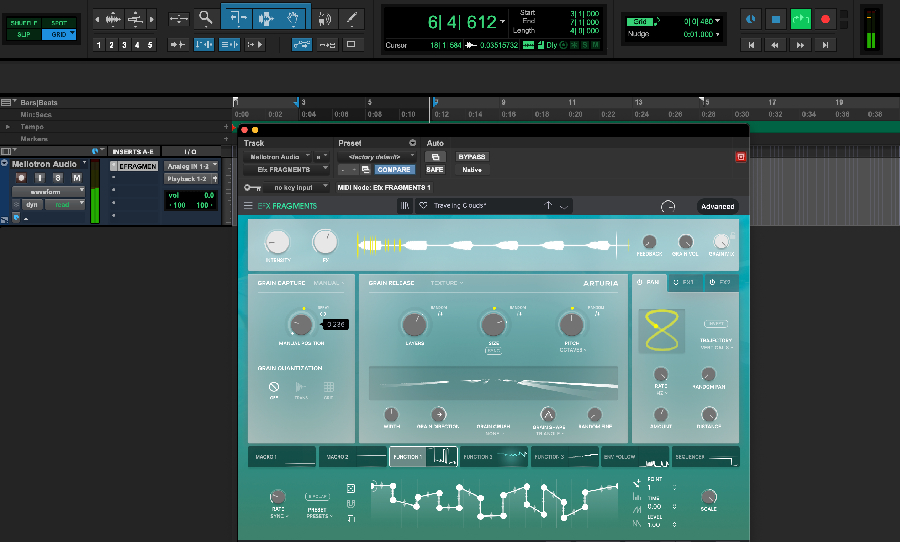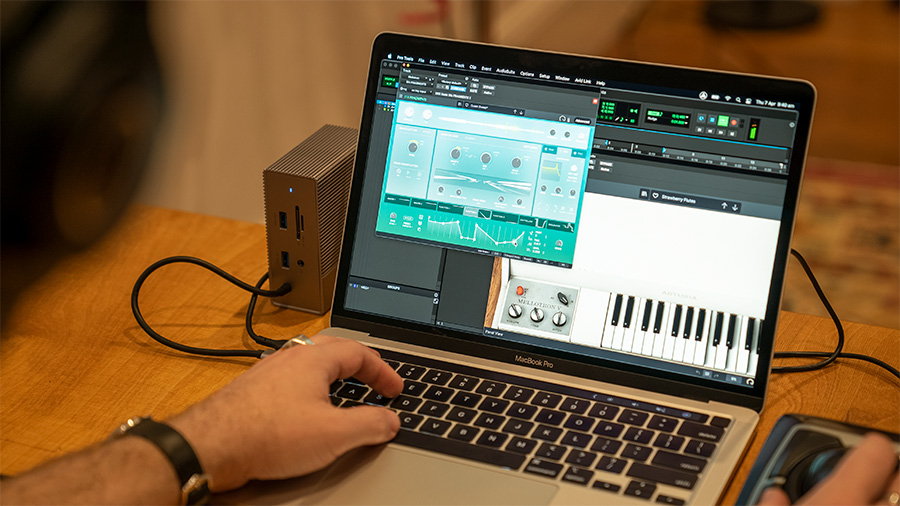Arturia has just released a new plugin called Efx Fragments. We took a closer look at this epic granular effect.
In the plugin world, Arturia is known for its amazing replications of classic synthesizers and classic effects. They have just released a new plugin called Efx Fragments: a software effect that uses granular processing to create sounds you never would have dreamed of.
Let’s dive into Efx Fragments to explore its functionality, user interface, and sound.

How does Efx fragments work?
Efx fragments is a plugin using granular synthesis. It takes a sound source, stores it in a buffer, and processes effects. This could be any audio source — from a recorded part or MIDI part — and the sampling range is from an eighth of a bar up to four whole bars.
Using Arturia’s Mellotron V, I created a four-bar loop and inserted the Efx fragments plugin after that. To get an adventurous and heavily warped sound, I used the grain volume and mix to blend of the mellotron part and the Efx fragment.
There’s a huge range of creative controls at your disposal and things can get very wild in the best possible way. You can turn that dry, characterless sound source into an ear-bending tone from another dimension. At one point I used it off a send — rather than on the track — and the result was an effect behind the original sound. Let’s dive into the panels and their functions.
What are all these controls?
On the top toolbar, there are all the usual Arturia plugin offerings — save, import, and export presets, resize window, master volume, tutorials, and help. There are two views to the plugin: basic and advanced.
Opening the advanced view gains you access to the full parameters of the plugin, including two waveform displays. It’s fun and informative when you see these waveform displays change as you tweak the knobs.
The Top Panel
The top panel holds the intensity, FX, feedback, grain volume and mix controls, along with a waveform display of what sound source is being sent into the buffer. If you hover over this section hidden controls show up — buffer length, freeze, clear (reset), and play head retrigger.
Intensity and FX — the first two controls on the left — are macros that control multiple parameters at once. Intensity controls the parameters of the granular synthesis engine itself, while FX controls the pan and the two FX sections — found in the panel in the middle on the far right. The panning and FX you create there will be controlled by this FX knob. A simple and effective way to create complex soundscapes.
Using the hidden controls, you can change the buffer length — and there’s a drastic change in sound when you let the buffer process more audio. I found the freeze button a lot of fun when I triggered it on the last note of the progression, to send that last note into an endless chasm of space. Engaging the clear button doesn’t stop the effect, it just resets it — so no awkward cut. A simple and intuitive feature that I really loved.
In the last of the hidden controls, there’s the Play Head Trigger. It works in conjunction with the Speed control in the Grain Capture section (in speed mode). To the right, there’s the Feedback, Grain Volume and Grain Mix.

The Middle Panel
In this section, there’s Grain Capture, Grain Release, Pan, and two FX. Grain Capture determines how the play head scans the buffer (the sound source input). I found that with a little experimentation, the Grain Capture module becomes clearer.
Grain Capture has three modes: Speed, Offset and Manual Scan. Speed is either divided or multiplied by two. Offset has times between zero milliseconds and 1000 milliseconds, while Manual Scan allows you to move the play head start position. Efx Fragments has a Spray control right next to the knob which can be clicked through to send the grains left or right or in both directions.
Grain Release is perhaps the most fun and versatile section in the plugin. Its main functions are Density, Size, and Pitch, while the controls on the bottom section are Width, Grain Direction, Grain Crush, and Grain Shape.
The Pan and FX provide a lot of variety, with a plethora of panning options and FX to choose from, including filters, distortions, reverb, echo, and chorus.
The Bottom Panel
Containing far too much to mention in the bottom panel are two macro-control sections, two function sections, an envelope follow, and a sequencer. There’s so much clicking and dragging you can do here, along with creating nodes to edit the shapes in all these areas.
The overall experience with Efx Fragments was impressive. I found it summoned me so deep into creating an epic soundscape that I almost forgot that I had to write this article! Whether you use it on an instrument or sound source, or via an auxiliary send, you’ll find ample opportunities for experimentation.
Head over to the Arturia website to see more details or buy Efx Fragments.



